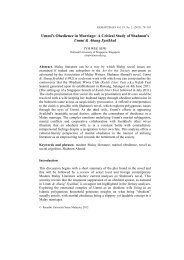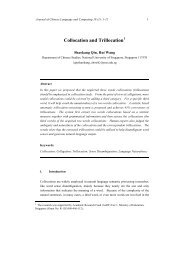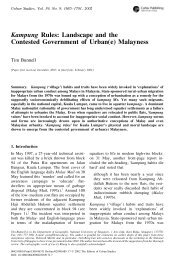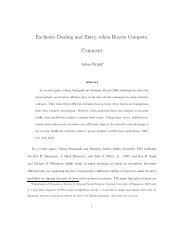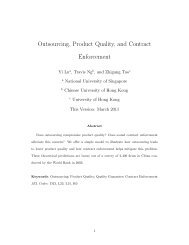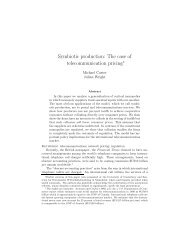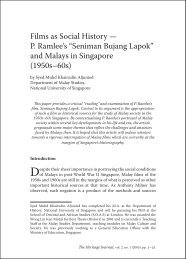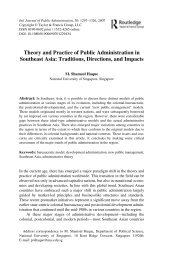Multihoming and compatibility
Multihoming and compatibility
Multihoming and compatibility
Create successful ePaper yourself
Turn your PDF publications into a flip-book with our unique Google optimized e-Paper software.
T. Doganoglu, J. Wright / Int. J. Ind. Organ. 24 (2006) 45–67 49benefits highly (high types) <strong>and</strong> have b =b H . The remaining consumers, a fraction of 1 k,do not value the network benefits highly (low types), <strong>and</strong> have b =b L z0. Naturally, weassume that b H Nb L <strong>and</strong> 0bk b1.The net utility of a consumer of type b located at x a [0,1] when she purchases fromfirm i is given byU i ðx;b;N i Þ ¼ v p i t i ðÞþbN x i ;ð1Þfor i =1, 2, where v is the intrinsic benefit 6 of the service, p i is the (uniform) subscriptionprice of firm i, transportation costs t i (x) equal tx for firm 1 <strong>and</strong> t(1 x) for firm 2, <strong>and</strong> N irepresents the total number of consumers that can be reached by subscribing to firm i.When the same consumer multihomes, subscribing to both firms, the net utility she gets isUðx;b;NÞ ¼ v p 1 p 2 t 1 ðÞ xt 2 ðÞþbN; xwhere N represents the total number of consumers that can be reached by subscribing toboth firms. 7 The utility of a multihoming customer can be further simplified toUðx;b;NÞ ¼ v p 1 p 2 t þ b; ð2Þgiven N =1 (multihoming ensures all consumers can be reached) <strong>and</strong> t 1 (x)+t 2 (x)=t (thetotal distance of travelling to both firms is always unity).We assume that firms set prices in stage 1 <strong>and</strong> consumers subscribe to one or both firmsin stage 2. We look for subgame perfect equilibria, which implies that consumers formrational expectations to determine the size of each network given the prices set in stage 1.2.1. Incompatible firms without multihomingThis section provides a benchmark for later results as it corresponds to the existingliterature which ignores the possibility of multihoming. The case without multihomingalso corresponds to a situation where firms choose to make their services exclusive. Let s i<strong>and</strong> n i denote the share of high <strong>and</strong> low types that subscribe to firm i respectively. Sincethere are k high types <strong>and</strong> 1 k low types, the total number of consumers that can bereached by subscribing to firm 1 is N 1 =ks 1 +(1 k)n 1 . Likewise N 2 =ks 2 +(1 k)n 2 . Thelocations of the indifferent consumers at each segment must solve U 1 (s 1 , b H , N 1 )=U 2 (s 1 ,b H , N 2 ) <strong>and</strong> U 1 (n 1 , b L , N 1 )=U 2 (n 1 , b L , N 2 ), which, after simplifications, yields 1 ¼ 1 2 þ p 2 p 12tþ b Hðp 2 p 1 Þ2tðtbÞn 1 ¼ 1 2 þ p 2 p 12tþ b Lðp 2 p 1 Þ;2tðtbÞ6 We assume that the intrinsic benefit, v, is sufficiently high that all consumers subscribe to at least one firmthroughout the paper.7 We treat transportation costs literally <strong>and</strong> sum them. Possible interpretations of this include costs of signing upfor a service, or the initial set up costs required for adopting a product or service. However, intrinsic benefits areonly obtained once.
50T. Doganoglu, J. Wright / Int. J. Ind. Organ. 24 (2006) 45–67where s 2 =1 s 1 , n 2 =1 n 1 <strong>and</strong> b =kb H +(1 k)b L is the average value of the networkbenefits parameter b. Using these expressionsN 1 ¼ 1 2 þ p 2 p 12ðt bÞ ; ð3Þ<strong>and</strong> given that the market is covered, N 2 =1 N 1 . Note that the market shares are moresensitive to prices than a normal Hotelling model due to the effect of prices on consumerexpectations about network sizes. An increase in the price of firm 1 decreases the relativeutility of customers of firm 1 not only due to its direct effect, but also via a decrease in theexpected network size of firm 1 <strong>and</strong> an increase in the expected network size of firm 2.To avoid the possibility of cornered market equilibrium, we will adopt the assumptionthat the transportation cost parameter is greater than the relevant network benefitsparameter; that is:Assumption 1. t Nb.If this assumption does not hold, a consumer located closest to firm 2 may still bewilling to buy from firm 1 at equal prices if she expects everyone else to do so. This raisesthe possibility of multiple consistent network sizes for given prices. In Section 4, we relaxAssumption 1 by considering the case without product differentiation. Since b H Nb L ,Assumption 1 also implies t N b L N(1 k)b L , a property we use repeatedly.Firm i obtains profits ofp i ¼ ðp i f ÞN i :Substituting (3) into profits for i =1, 2, taking the first-order conditions <strong>and</strong> solving out forprices implies equilibrium prices ofp N4up 14 ¼ p 24 ¼ f þ t b:These are the same prices that arise in a model in which all consumers have networkbenefits parameter equal to b. Equilibrium prices are lower than the usual Hotelling pricesdue to the increased price sensitivity of dem<strong>and</strong> under network effects. 8 Given that thefirms equally share the market, the corresponding equilibrium profits for each firm equalsp N4 ¼ t b2 2 ;which is positive given Assumption 1.Aggregate welfare is defined as the weighted sum of the consumers’ <strong>and</strong> the firms’surpluses. Since unit dem<strong>and</strong>s are assumed, the possibility that higher prices lower welfareis captured by allowing the possibility that firms’ surplus is discounted relative toconsumer surplus. Let the weight on producer surplus in aggregate welfare be a where0Va V1. Equilibrium welfare without multihoming is thenW N4 ¼ v þ b tt bf 21 ð aÞ:2 42 28 This consequence of network effects is known in the theoretical literature (Shy, 2001). It has also beenconfirmed in an experimental setting (Bayer <strong>and</strong> Chan, 2004).
T. Doganoglu, J. Wright / Int. J. Ind. Organ. 24 (2006) 45–67 51The first two terms are the intrinsic <strong>and</strong> network benefits when there is no <strong>compatibility</strong><strong>and</strong> no multihoming. The third <strong>and</strong> fourth terms represent the costs of providing theservice <strong>and</strong> consumers’ average transportation costs. In addition, to the extent the firms’surplus is discounted, welfare is decreasing in the firms’ margins. Firms earn high marginsif their products are more differentiated (transport costs are high) <strong>and</strong> low margins ifnetwork effects are strong (in which case firms compete aggressively in an attempt tocapture the whole market).2.2. Compatible firmsWhen firms are compatible, there are no product specific network effects as allconsumers will be able to connect with one another regardless of which firm they join.This means N i =1, <strong>and</strong> there is no reason to multihome. As network benefits offered byboth firms are constant <strong>and</strong> equal, they cancel out in computing the location of theindifferent consumer, yielding the st<strong>and</strong>ard Hotelling share functions in both segmentss 1 ¼ n 1 ¼ 1 2 þ p 2 p 1;2t<strong>and</strong> n 2 =s 2 =1 n 1 .We assume that achieving <strong>compatibility</strong> costs each firm a fixed amount F <strong>and</strong> isattained only when both firms undertake this investment. This ensures that there is no freeriding problem in our framework since if <strong>compatibility</strong> raises profits, then each firm willbe willing to incur the cost F given the rival firm also does. Thus, the firms will coordinateon the equilibrium with <strong>compatibility</strong>. 9The profit of firm i is thereforep i ¼ ðp i f Þðks i þ ð1 kÞn i Þ F:Solving the first-order conditions, the corresponding equilibrium prices are the normalHotelling equilibrium pricesp4up C 14 ¼ p4 2 ¼ f þ t:Equilibrium profits are simplyp C4 ¼ t 2F;<strong>and</strong> equilibrium welfare istW C4 ¼ v þ b f 2F 21 ð aÞ t F :42In this case, welfare includes the maximal amount of network surplus. Relative to the no<strong>compatibility</strong><strong>and</strong> no-multihoming case, network benefits are doubled but welfare islowered by the fixed costs of achieving <strong>compatibility</strong> <strong>and</strong> by higher prices (in the case thatconsumer surplus is valued more than producer surplus).9 Alternatively, we could have assumed only one firm has to incur the cost, but still obtained the same outcomeby assuming the firms can first negotiate over whether to achieve <strong>compatibility</strong> <strong>and</strong> how to share costs.
52T. Doganoglu, J. Wright / Int. J. Ind. Organ. 24 (2006) 45–672.3. The benchmark without multihomingGiven the symmetry of firms, their unilateral <strong>and</strong> joint incentives to make theirservices compatible are identical. For a given F, firms will make their services compatibleonly if there is an increase in equilibrium profits; that is, if p C* is higher than p N*,orequivalently ifFb b 2 uFP N :This condition trades off the higher margins to a firm resulting from <strong>compatibility</strong> (under<strong>compatibility</strong>, firms no longer compete to capture network effects) with the costs ofreaching <strong>compatibility</strong>. Comparing W N* <strong>and</strong> W C*, a social planner will wish the services ofthe firms to be made compatible ifFb b b2 4a uFW N :Whether the firms or the social planner will choose <strong>compatibility</strong> depends on the valueof the fixed costs of achieving <strong>compatibility</strong>, F. Their incentives are aligned for bothsufficiently low values <strong>and</strong> sufficiently high values of F. In contrast, for F W N bF bF P N , thefirms will choose <strong>compatibility</strong> even though this lowers welfare. For this range of costs,<strong>compatibility</strong> does not raise network benefits enough to cover the costs of achieving it.However, it raises industry profits more, reflecting that <strong>compatibility</strong> makes dem<strong>and</strong>s lessprice sensitive. This results in a transfer from consumers to firms, which increases profitsbut not welfare. We thus have:Proposition 1. Firms have an excessive incentive to choose <strong>compatibility</strong> in the absence ofmultihoming.This proposition is consistent with the results from the existing literature on network<strong>compatibility</strong> with price competition (such as those in Shy, 2001) <strong>and</strong> shows that theseresults extend to the case where consumers have heterogeneous valuations of networksizes. However, it is in contrast to the earlier results of Katz <strong>and</strong> Shapiro (1985) in whichquantity setting homogenous-goods firms may have insufficient incentives to make theirproducts compatible since they cannot capture the full surplus from doing so. In Section 4,we consider the case of homogenous products in our framework (by setting t =0), wherelike Katz <strong>and</strong> Shapiro we also find firms can have an insufficient incentive for<strong>compatibility</strong> in the absence of multihoming.2.4. Incompatible firms with multihomingIn this section, we allow consumers to multihome, that is, to subscribe to both firms.We can immediately rule out some cases. First, there are no equilibria in which allconsumers multihome, since then when faced with positive prices each individualconsumer has no reason to multihome. Second, we are not interested in parameter valuesfor which no consumer chooses to multihome in equilibrium, as in this case allowingconsumers to multihome will not change the results. Given our assumption b L bb b t, we
T. Doganoglu, J. Wright / Int. J. Ind. Organ. 24 (2006) 45–67 53can also rule out the case in which some low types multihome—the added transportationcosts of them doing so always exceeds their gain in network benefits. 10 Instead, we willfocus our analysis on an equilibrium where all low types singlehome (subscribe to onefirm only) <strong>and</strong> all high types multihome. The only other possibility, in which some hightypes multihome while all low types singlehome, makes the analysis significantly morecomplicated without providing additional insights.Formally, all high types multihoming <strong>and</strong> all low types singlehoming implies s i =1 <strong>and</strong>N i =k +(1 k)n i for i =1, 2. Subscribing to firm i exclusively allows a consumer to reachall high types <strong>and</strong> a share n i of low types. As a result, the share of singlehomingconsumers that join firm 1 is found by solving U 1 (n 1 , b L , N 1 )=U 2 (n 1 , b L , N 2 ) for n 1which impliesn 1 ¼ 1 2 þ p 2 p 12ðt ð1 kÞb L Þ ;<strong>and</strong> n 2 =1 n 1 . Assumption 1 is sufficient to ensure the market share equation is wellbehaved.Furthermore, it is straightforward to verify using the expression for n 1 that thetotal dem<strong>and</strong> as well as the network size of firm i is given byN 1 ¼ 1 2 þ k 2 þ ð1kÞð p 2 p 1 Þ2ðt ð1 kÞb L Þ : ð4ÞComparing the total dem<strong>and</strong> faced by firm 1 without multihoming from (3) with that in(4), note that it shifts up by k /2 <strong>and</strong> its price sensitivity changes. In particular, the totaldem<strong>and</strong> faced by firm 1 is less price sensitive when multihoming is allowed since2ðt ð1 kÞb L Þ2ðt kb H ð1 kÞb L Þ ¼ 2k ð t þ ð b H b L Þð1 kÞÞz0:1 k1 kThe reduction in price sensitivity combined with the upward shift in the dem<strong>and</strong> impliesthat firms will charge higher prices when multihoming is allowed.The profits of firm i arep i ¼ ðp i f ÞN i :Substituting the share function into profits for i =1, 2, taking the first-order conditions,solving out for prices, <strong>and</strong> simplifying implies c<strong>and</strong>idate equilibrium prices ofp M4 up4 1 ¼ p4 2 ¼ f þ 1 þ k ð1 k t ð1kÞbLÞ: ð5ÞGiven Assumption 1, c<strong>and</strong>idate equilibrium prices exceed costs f. In a technical Appendixto the paper, we show that there is a set of parameters for which prices given in (5)10 A similar logic explains why we need heterogeneous valuations of network sizes to obtain multihoming as anequilibrium outcome. Suppose all consumers obtain the same network benefits, say b bt, <strong>and</strong> prices are nonnegative,then a necessary condition for multihoming is that tx bb(1 N 1 ) <strong>and</strong> t(1 x)bb(1 N 2 ). With somemultihoming, N 1 N0, N 2 N0, <strong>and</strong> N 1 +N 2 N1, so that there is no x a [0,1] for which these conditions can all hold.
54T. Doganoglu, J. Wright / Int. J. Ind. Organ. 24 (2006) 45–67constitute a pure strategy equilibrium. 11 The existence of such an equilibrium requires b Hto be sufficiently large relative to b L , but not too large, <strong>and</strong> most importantly that f is nottoo high.In setting its price, each firm trades off the benefits of a higher price on its installed baseof customers with a lower market share of singlehoming consumers. The existence ofsinglehoming consumers disciplines the prices that firms can charge, forcing them to takeinto account the usual competitive pressures on at least a portion of their customers. Themarket share of low types is still more sensitive to price than in a normal Hotellingframework because of the network benefits that arise from attracting additional low types(assuming b L N0). However, it is less sensitive to price than the case without multihoming.This reflects the fact that with multihoming, high types can be reached regardless of whichfirm low types subscribe to, reducing the impact of network effects on the pricing behaviorof the firms. Moreover, the number of high types attracted does not depend on prices at themargin. We therefore get: 12Proposition 2. Equilibrium prices <strong>and</strong> profits are higher when consumers are able tomultihome compared to when they are not.Firms earn higher profits when more consumers multihome, both through higher pricesas a result of the reduction in the price elasticity of dem<strong>and</strong>, <strong>and</strong> through greater dem<strong>and</strong>compared to the case without multihoming. An implication of this result is that wheneverthe firms can decide in a prior stage whether to require exclusivity from their customers(say as a technology choice, or through the use of an exclusive contract), they will notwant to make their services exclusive. If either firm forces consumers to chooseexclusively between itself or its rival, then price competition will be more intense <strong>and</strong> thefirms will face lower dem<strong>and</strong>. That firms prefer to allow multihoming, together with thepossibility that it is often difficult (or perhaps illegal) 13 to impose such exclusivity, furtherjustifies our focus on the equilibrium with multihoming.Equilibrium welfare under multihoming is thenW M4 ¼ v þ kb H þ 1ð1þ k2Þ2k 2 b L2t1 k b L :ð1 þ kÞf ð1 þ 3kÞ t 421 ð aÞThe first three terms measure the intrinsic <strong>and</strong> network benefits. The networkbenefits obtained by low types are now higher than without multihoming, reflectingthe ability of low types to reach high types that multihome. 14 The fourth <strong>and</strong> fifth11 This Appendix is available on the journal website.12 The proof of the proposition, as with all subsequent ones, is given in the Appendix.13 One can imagine PlayStation only dealing with game developers who write software exclusively for theirplatform, or Visa only signing up merchants which do not accept rival cards, but it is difficult to imagine howfirms can enforce exclusivity on consumers.14 The network benefits obtained by the 1 k low types are equal to b L , a fraction k of the time (since they canreach all high types) <strong>and</strong> are equal to b L /2, a fraction 1 k of the time (since they can only reach the low typesthat are subscribed to the same firm). Then (1 k) (k +(1 k)/2)b L =(1 k 2 )b L /2.
T. Doganoglu, J. Wright / Int. J. Ind. Organ. 24 (2006) 45–67 55terms represent the costs of providing the service <strong>and</strong> consumers’ average transportationcosts. Note that the costs of providing the service includes some duplication ofsubscription costs to the extent there is multihoming (so costs equal 2f a fraction k ofthe time, <strong>and</strong> equal f a fraction 1 k of the time). Similarly, transportation costs equal t afraction k of the time <strong>and</strong> equal t /4 a fraction 1 k of the time. In addition, to the extentthat the firms’ profits are discounted relative to consumer surplus (a b 1), multihominglowers welfare by raising prices <strong>and</strong> transferring surplus to firms. This is reflected in thelast term.Given the result in Proposition 2, that firms will prefer not to make their servicesexclusive, it is interesting to evaluate the welfare implications of this outcome. Comparingwelfare with <strong>and</strong> without multihoming, we get that:Proposition 3. Assume a multihoming equilibrium exists. Then there exists an âa [0, 1]such that welfare is higher under multihoming (W M zW N ) whenever the social plannervalues profits sufficiently (azâ) <strong>and</strong> welfare is higher without multihoming (W M bW N )whenever the social planner puts sufficiently low weight on profits (abâ).For high values of a, the social planner values firms’ profits similarly to consumersurplus, so that the increased prices are seen largely as a transfer from consumers to firms.In this case, the presence of multihoming raises overall welfare. Consumer surplusincreases, reflecting that high types choose to multihome, which also confers a positiveexternality on low types. Moreover, firms are also better off (Proposition 2). On the otherh<strong>and</strong>, multihoming has a negative impact on competitiveness, which obviously decreasesconsumer surplus, so that when the social planner is sufficiently concerned aboutconsumer surplus it will prefer the case with exclusivity.2.5. Private versus social <strong>compatibility</strong> decisionsWhen multihoming is possible, the incentives for <strong>compatibility</strong> become morecomplex. Given that consumers can multihome, firms will prefer to make their networkscompatible ifFb ð1þ k2Þ2 b Lkð3 þ kÞt21 ð kÞ uFP M :Clearly, when b L =0, so that low types get no network benefits, the firms will never maketheir services compatible when consumers can instead multihome (at least, for nonnegativecosts of achieving <strong>compatibility</strong>). In this case, the price sensitivity of dem<strong>and</strong>with multihoming is lower than its level under <strong>compatibility</strong>. With multihoming, thedem<strong>and</strong> of high types does not depend on price at the margin, while the dem<strong>and</strong> of lowtypes has the same sensitivity to price as in the case of <strong>compatibility</strong>. Furthermore, giventhe additional upwards shift in the dem<strong>and</strong> due to double purchase by high typeconsumers, firms are able to sustain higher prices <strong>and</strong> earn higher profits than they canwhen they are compatible. Thus, even if there is no cost of achieving <strong>compatibility</strong>, firmswill prefer to remain incompatible.
56T. Doganoglu, J. Wright / Int. J. Ind. Organ. 24 (2006) 45–67Comparing W M * with W C *, a social planner will wish the networks to be madecompatible ifFb2þ kf þ 3ktð1þkÞ 4þ ð1 aÞ21 kðt ð1 kÞb L Þ tuFM W 2a:ð1 kÞ 2 b LCompared to the case without multihoming, there are a number of new effects.In<strong>compatibility</strong> now implies duplicated costs of customers subscribing to both firms(the term kf) <strong>and</strong> added transportation costs as customers travel to both firms (the term3kt /4), neither of which affect the firms’ <strong>compatibility</strong> decision. On the other h<strong>and</strong>, thelosses in network benefits due to in<strong>compatibility</strong> are now less than before since consumerscapture some of these benefits through multihoming anyway. Where the firms’ surplus isweighted less than consumer surplus, <strong>compatibility</strong> also leads to an increase in welfare tothe extent that prices are higher under the multihoming equilibrium. With a much reducedprivate incentive for <strong>compatibility</strong> <strong>and</strong> a generally increased social incentive for<strong>compatibility</strong>, for a range of parameter values firms will have an insufficient incentiveto choose <strong>compatibility</strong>.Proposition 4. There exists b¯ L such that (i) whenever b L bb¯ L, firms have an insufficientincentive to choose <strong>compatibility</strong> (that is, F P M bF W M). (ii) When b L Nb¯ L, firms have anexcessive incentive to choose <strong>compatibility</strong> (that is, F W M b F P M); <strong>and</strong> (iii) if in additionabâ defined in Proposition 3, this excessive incentive of firms to choose <strong>compatibility</strong>is reduced as a result of the ability of consumers to multihome (that is, F W N bF W M bF P M bF P N ).Proposition 4 shows that the possibility of multihoming may completely overturn theexcessive tendency towards <strong>compatibility</strong> obtained for the benchmark case withoutmultihoming. For instance, when the network benefits of low types are sufficiently low, wehave already noted that firms will prefer in<strong>compatibility</strong> even if there are no costs toachieve <strong>compatibility</strong>. This means that there are times when a social planner will prefer<strong>compatibility</strong> although firms will not (but the reverse is not true).For b L Nb¯L, however, firms still have an excessive incentive towards <strong>compatibility</strong>, asin our benchmark model (that is, F W M bF P M). Nevertheless, the firms’ excessive tendencytowards <strong>compatibility</strong> is unambiguously reduced as a result of multihoming when thesocial planner places a sufficiently low weight on the profits of the firms relative toconsumer surplus. In this case, we find that F W N bF W M b F P M bF P N , so that for any fixedcosts F where firms choose <strong>compatibility</strong> inefficiently under multihoming, they will dothe same in the absence of multihoming (but the reverse is not true). In these cases,multihoming reduces the problem of firms choosing <strong>compatibility</strong> when they shouldnot.Regardless of parameter values, we can show that F P M F W M bF P N F W N . In particular,whenever b L Nb¯, we have 0bF P M F W M bF P N F W N . This result implies that the rangeof fixed costs where social <strong>and</strong> private incentives for achieving <strong>compatibility</strong>diverge is reduced. Clearly, this is a weaker statement than that in Proposition 4as it allows the possibility of some fixed costs F for which multihoming results in firms
T. Doganoglu, J. Wright / Int. J. Ind. Organ. 24 (2006) 45–67 57choosing <strong>compatibility</strong> inefficiently where they will not otherwise. Nevertheless, itimplies:Proposition 5. Whenever b L Nb¯ L, the ability of consumers to multihome means that thereis a smaller range of fixed costs of achieving <strong>compatibility</strong> for which firms have anexcessive incentive towards <strong>compatibility</strong>.Whether Proposition 5 can be interpreted as a reduced tendency for firms to chooseexcess <strong>compatibility</strong> depends on how one interprets F. Since we wish to consider theincentives for <strong>compatibility</strong> over a range of possible values of F, suppose F is r<strong>and</strong>omlydrawn from the uniform distribution. Then, the probability that a <strong>compatibility</strong> problemexists is proportional to the range of values of F for which private <strong>and</strong> social incentives arenot aligned. In this case, Proposition 5 implies that there is a smaller likelihood of fixedcosts F arising for which firms have an excessive incentive towards <strong>compatibility</strong> as aresult of consumers’ ability to multihome. 15The effects of multihoming on private <strong>and</strong> social incentives to achieve <strong>compatibility</strong>can be explained intuitively as follows. First, take the case without multihoming. There aretwo opposing effects. The first effect comes from assuming prices are fixed. With fixedprices, firms do not profit from <strong>compatibility</strong> since they each still serve half of allcustomers, although <strong>compatibility</strong> raises network benefits as well as welfare. Thus, firmswould have no incentive to choose <strong>compatibility</strong> even though welfare increases by b /2.The second effect comes from the fact firms will charge higher prices in the presence of<strong>compatibility</strong>, given that dem<strong>and</strong> is less elastic. The higher prices have no impact onwelfare (at least when a =1), while they increase industry profit by b. Comparing the twoeffects, the increase in profits is higher than the increase in welfare with <strong>compatibility</strong>,implying a higher incentive for firms to choose <strong>compatibility</strong> than the social planner.Now consider how things change when we allow for multihoming. The first effectbecomes less important, since some additional network benefits are now realized evenwithout <strong>compatibility</strong>. The second effect also becomes less important, since firms willprice higher even in the absence of <strong>compatibility</strong> due to the decreased strength of networkeffects as a result of multihoming. The net effect is to reduce the excessive incentive tochoose <strong>compatibility</strong>. 16 In addition, there are a number of new effects that arise from hightypes multihoming. First, each firm faces higher dem<strong>and</strong> from high types that buy fromboth firms. This raises the firms’ profit directly, <strong>and</strong> also indirectly by causing them to sethigher prices given that each faces a greater installed base of customers. This increase inprofit is a transfer from consumers to firms, providing firms with too much incentive toavoid <strong>compatibility</strong>. In addition, <strong>compatibility</strong> now results in two new welfare gains whichfirms fail to internalize. First, there is the saving of the duplication in costs kf that wouldotherwise arise from multihoming consumers. Firms just price to recover their own costs,so that each firm ignores additional costs to society of kf /2 under multihoming. Likewise,there is the saving of the duplication in transportation costs 3kt /4 that arise from15 For other distributions for F, this statement needs not be true.16 The closer b L is to zero, the greater the reduction in the excessive incentive to choose <strong>compatibility</strong> as a resultof multihoming. To see this, consider the case with b L =0. Then all network benefits are realized both with <strong>and</strong>without <strong>compatibility</strong>, so the first <strong>and</strong> second effects vanish.
58T. Doganoglu, J. Wright / Int. J. Ind. Organ. 24 (2006) 45–67multihoming consumers which firms ignore. For instance, these costs can include the costsof consumers having to deal with two different firms or the costs of having to learn to usetwo different services. Both of these effects provide further reasons why <strong>compatibility</strong> issocially desirable even though firms prefer in<strong>compatibility</strong>.Somewhat paradoxically, the ability of consumers to multihome means policymakersmay need to be more concerned about <strong>compatibility</strong>. Our results imply that this is morelikely to be the case when network benefits are lower for low-value consumers, when thereare more high-value (multihoming) consumers, when transportation costs are higher <strong>and</strong>when the cost of providing the service to each user is higher. This suggests thatpolicymakers may have a reason to be concerned about firms which do not make theirnetworks compatible in situations in which some consumers choose to multihome, wherethis multihoming involves significant duplication of costs, where this multihoming occursthrough consumers subscribing to a second firm’s service that is distant from theirpreferred choice <strong>and</strong> where some consumers put little value on network benefits. On theother h<strong>and</strong>, when firms do choose <strong>compatibility</strong>, our results suggest that policymakersshould be less concerned that such <strong>compatibility</strong> is actually inefficient (or being used toreduce competition) given the ability of consumers to multihome.2.6. An application to instant messagingA recent public issue where our results could have been of use is related to the mergerbetween AOL <strong>and</strong> Time Warner, which the FCC approved subject to conditions in January2001. One area put under scrutiny was instant messaging (IM) services provided byAOL. 17 These services allow users to exchange messages with members who are presentin a special directory. If competitors’ directories are incompatible, then IM services exhibitfirm specific network effects. A main concern of the FCC was that in the presence of thesenetwork effects, AOL’s resistance to being compatible with competing IM providers,combined with the assets of Time Warner allowing high-speed data transmission, wouldmean that AOL’s dominance of IM would translate to dominance in the market foradvanced IM-based high-speed services.Initially the FCC was of the view that provided the industry was one in which operatorshad similar subscriber bases, then firms would have sufficient incentives to achieve<strong>compatibility</strong>. 18 At the time, competitors of AOL’s IM, Microsoft <strong>and</strong> Yahoo! engaged insignificant lobbying activity to get FCC involved in the imposition of <strong>compatibility</strong>. AOL(2000) argued that any incompatibilities between different services are mitigated by meansof consumers subscribing to multiple IM services simultaneously (multihoming), a viewthe FCC rejected. In fact, the order explicitly states b...We find the ability of users to useseveral IM services is not a substitute for interoperability...Q 19 In their arguments, the FCC17 The discussion we present here is based on official <strong>and</strong> public documents that can be found at the FCC website(http://www.fcc.gov/mb/aoltw/aoltw.html). In particular, we use the order conditionally approving the merger(FCC, 2000), the second order which relieved AOL <strong>and</strong> Time Warner from the conditions set in the first order(FCC, 2003) as well as documents submitted by AOL (AOL, 2000) <strong>and</strong> experts (Faulhaber <strong>and</strong> Farber, 2003).18 FCC (2000), paragraph 154, p. 67.19 FCC (2000), paragraph 164, pp. 71–72.
T. Doganoglu, J. Wright / Int. J. Ind. Organ. 24 (2006) 45–67 61side of the market only induces an indirect feedback effect in a two-sided market, giventhat the price on the other side is fixed. On the other h<strong>and</strong>, given that profits are obtainedfrom both groups, each platform now takes into account that any increase in price on oneside of the market will reduce dem<strong>and</strong> on the other side.To see how these two effects combine, note that the profit function of platform i isp i ¼ p A i f Ni A þ p B i f Ni B :Choosing the profit-maximizing prices for platform i, <strong>and</strong> exploiting symmetrybetween the two platforms, we can express the equilibrium price on each side ofthe market as p A b bi ¼ f þ t b þ b 1p B i f t t p B b bi ¼ f þ t b þ b 1t tp A i f :Comparing these prices to the prices ( p N *=f +t b) in the one-sided market case,the first additional term measures the extent to which prices are now higher due todecreased price elasticity, while the second additional term measures the extent towhich prices are now lower due to the cross-market externality effect. Solving thetwo equations simultaneously it is clear that the two additional terms exactly canceleach other out. The result is that platforms will set identical prices to those in theequivalent one-sided market, so that equilibrium profit for each platform is 2p N* <strong>and</strong>welfare is 2W N*, where these expressions are defined in Section 2.1. This analysisshows that there are offsetting effects when one moves from one-sided to two-sidedmarkets <strong>and</strong> it is not necessarily the case that one particular effect will dominate the other.4. Strong network benefitsSo far our results have been derived in situations where the effect of productdifferentiation is assumed to be stronger than that of network benefits. In this section, weexplore what can happen if this assumption is reversed by considering the special case inwhich there is no product differentiation. It is known that in the absence of productdifferentiation firms will generally have insufficient incentives to make themselvescompatible. 24 We are interested in how the possibility of multihoming affects this<strong>compatibility</strong> problem.One possibility is that firms are able to choose (in a prior stage) whether to allowmultihoming or whether to make their services exclusive. With pure network benefits, adominant firm (enjoying favorable beliefs) will prefer exclusivity, in which case24 See, for instance, Katz <strong>and</strong> Shapiro (1985) for the quantity competition case.
62T. Doganoglu, J. Wright / Int. J. Ind. Organ. 24 (2006) 45–67multihoming is not an option that has to be considered in the analysis of <strong>compatibility</strong>.This provides one justification for our focus on the case with product differentiation.Of course, it may not be feasible for firms to stop consumers from multihoming. Evenso, the possibility of multihoming can still be irrelevant. In a one-sided market setting withprice competition it is natural to consider the case where all consumers buy from a single(dominant) firm. For instance, this outcome arises if beliefs stubbornly favor one firm overanother (say the incumbent over the entrant). A rival firm that undercuts cannot profitablyattract dem<strong>and</strong> since consumers will not join a firm at a positive price if they do not expectany other consumers to do so. In this case, allowing consumers to multihome may be anirrelevant option, as consumers get maximal network benefits buying from the dominantfirm <strong>and</strong> so continue to coordinate on this firm. The dominant firm will be able to exploitnetwork effects to obtain maximal profits. In contrast, <strong>compatibility</strong> results in pricing atcost. The dominant firm will therefore oppose <strong>compatibility</strong>, as will the entrant if there areany costs of achieving <strong>compatibility</strong>. A social planner concerned with total surplus willalso oppose <strong>compatibility</strong> if there are any costs of achieving <strong>compatibility</strong>, since with onefirm taking the whole market the full network benefits will be realized. The possibility ofmultihoming does not affect this result since multihoming never arises in this setting. Onthe other h<strong>and</strong>, if the social planner prefers lower prices, it may favor a solution with<strong>compatibility</strong>, but the dominant firm will not sponsor any such move. Then, the ability ofconsumers to multihome does not solve (or change) the <strong>compatibility</strong> problem that ariseswhen there are strong network effects.The fact that the dominant firm will block <strong>compatibility</strong> when network effects arestrong <strong>and</strong> multihoming is not allowed also applies in a two-sided market context. To seethis, consider setting transportation costs <strong>and</strong> intrinsic benefits to zero in the model ofSection 3 but allowing for asymmetry. Suppose group A consists entirely of high types(k A =1) <strong>and</strong> group B consists entirely of low types (k B =0). Define the network benefits toeach group as b A <strong>and</strong> b B , such that b A =b H , b B =b L <strong>and</strong> b A N b B . Finally, assume that thepolicymaker is only concerned with total surplus (a =1), which ensures that in the absenceof multihoming both the platforms <strong>and</strong> the policymaker prefer in<strong>compatibility</strong> for anypositive cost of achieving <strong>compatibility</strong>.Without <strong>compatibility</strong> or multihoming, the dominant platform will set prices of b A togroup A <strong>and</strong> b B to group B. If agents coordinate on the dominant platform, it is impossiblefor a rival platform to profitably attract agents away. 25 The dominant platform will thenmake maximal profits of b A +b B f A f B , where we have allowed for different costs oneach side of the market. Since the platform extracts all the surplus, total surplus just equalsthe platform’s profit. The result is equivalent to the one-sided case above. The dominantplatform will oppose <strong>compatibility</strong>, which results in pricing at cost, as will the entrant <strong>and</strong>the social planner given any costs of achieving <strong>compatibility</strong>.Once we allow for multihoming, our model corresponds to that of chicken-<strong>and</strong>-eggcompetition in Caillaud <strong>and</strong> Jullien (2003, Section 5) in the special case where matching in25 This is not true if agents can multihome, as then a rival platform can bribe one group to multihome with aslightly negative price <strong>and</strong> then attract the other group by slightly undercutting the dominant platform’s price(a divide-<strong>and</strong>-conquer strategy).
64T. Doganoglu, J. Wright / Int. J. Ind. Organ. 24 (2006) 45–67MasterCard <strong>and</strong> Visa. Many consumers now hold multiple such cards <strong>and</strong> many merchantsaccept more than one card. Such multihoming may suggest that from a social point of viewthere is no reason to consider the case for forcing these networks to make their networkscompatible. Cardholders can choose to hold a single payment card <strong>and</strong> yet have littleproblem using their card at merchants. Likewise, merchants seldom cannot make a salebecause consumers lack the right card. However, multihoming can be costly, both directlyin terms of duplicated costs <strong>and</strong> the added inconvenience for users, but also indirectlybecause it can weaken competition between the platforms providing these services,making them less likely to prefer <strong>compatibility</strong> when it would otherwise be desirable.Thus, asking whether such networks should be made compatible is an interesting question,even in the presence of such widespread multihoming.Appendix AA.1. Proof of Proposition 2The difference in equilibrium prices caused by multihoming isp M4p N4 ¼ 1 þ k ð1 k t ð1kÞbLÞ t þ b¼1 þ k 1 ðt ð1 kÞb L Þþkb H N0:1 kThe corresponding equilibrium profits under multihoming arep M4 ¼ þ k Þ2 tb L ;2 1 kwhich is positive given Assumption 1. Comparing equilibrium profits with those withoutmultihoming,p M4 p N4 ¼ þ k Þ2 t t kb H þ ð1kÞb Lb L2 1 k2 2¼ 1 ð1 þ kÞ 2 1 k1!ðt ð1 kÞb L Þþ kb H2 N0: 5A.2. Proof of Proposition 3Let us parameterize the welfare function with a <strong>and</strong> denote it by W i (a), i ={M, N}.Observe that W M (a) W N (a) is increasing in a, sinceB½Ba W MðaÞW N ðaÞŠ ¼ kb H þ ð3 þ kÞkð t ð1kÞbLÞ1 kwhere the final inequality follows from Proposition 2.¼ 2ðp M 4 p4N ÞN0;
T. Doganoglu, J. Wright / Int. J. Ind. Organ. 24 (2006) 45–67 65Setting a =1 in the difference of welfare expressions with <strong>and</strong> without multihoming, weobtainW M ð1Þ W N ð1Þ ¼ 1 2 kb H þ 1 2 kð1kÞbL kfwhich is positive wheneverf V 1 2 b H þ 1 2 ð1kÞbL34 tux 4:34 kt;In a technical Appendix to the paper, available at the journal’s website, we show thathigh types multihome in equilibrium if <strong>and</strong> only iff b ð1kÞbH22tþ ð1 þ kÞb L1 k ux 0:Therefore, this is a necessary condition for the multihoming equilibrium we focus on toexist. Using these definitions, we havex 4 x 0 ¼ 1 3k 2 b L þ tþ 1 2 1 k 2 kb H þ 1 t b L2 1 k þ 3 kðtb L Þþ 1 t kb L4 1 k 4 1 k N0;<strong>and</strong> hence x 4 Nx 0 , yielding W M (1)NW N (1).Similarly, setting a =0 in the difference of welfare expressions with <strong>and</strong> withoutmultihoming yieldsW M ð0Þ W N ð0Þ ¼k 7kðt ð1 kÞb L Þkf2b H21 ð kÞk 2 ðt ð1 kÞb L Þb0;41 ð kÞkðt kð1 kÞb L Þ41 ð kÞimplying W M (0)bW N (0). Therefore, there must exist an âa[0, 1] such thatW M (â)=W N (â). Thus, for a zâ, we have W M (a)zW N (a), while W M (a)bW N (a), fora bâ. 5A.3. Proof of Proposition 4We haveFM P FM W ¼ 21þ 5k 5k2 k 3 b L 4kð1 81 ð kÞakÞf kð15 þ kÞt¼1 þ 6k þ k2 b L4awhich is negative wheneverb L b 2kð1k Þf þ k ð 15 þ k Þt1 kkf2akð15 þ kÞt81 ð kÞa ;ð Þ 1 þ 6k þ k 2 u¯b L :This implies F P M bF W M, proving the result in (i) <strong>and</strong> (ii).
66T. Doganoglu, J. Wright / Int. J. Ind. Organ. 24 (2006) 45–67On the other h<strong>and</strong>, for b L Nb¯L we have F W M bF P M, while a bâ implies W M bW N fromProposition 3, so that F W N b F W M. From Proposition 2 we have p M * Np N * , so that F P M bF P N .Combining these results gives F W N bF W M bF P M bF P N , which implies a reduction in theexcessive tendency towards <strong>compatibility</strong> proving (iii) in the proposition. 5A.4. Proof of Proposition 5Regardless of the value of b L bt, we haveFM P FM W FN P FNW ¼k 12kb L þ 2k 2 b L þ 21 ð kÞb H þ 15t 14b L þ 41 ð kÞf þ kt b0:81 ð kÞaIn particular, when b L Nb¯L, both with <strong>and</strong> without multihoming firms have excessiveincentives towards <strong>compatibility</strong>. However, the range of fixed costs where this excessiveincentive occurs is reduced with multihoming. 5A.5. Proof of Proposition 6When the platforms are made compatible, the prices will just be the normal Hotellingprices f +t as consumers get the same (maximal) network benefits irrespective of theplatform they join. Network benefits, regardless of whether they arise from agents from thesame group (in the one-sided case), or across groups (in the two-sided case), drop out ofthe dem<strong>and</strong> functions. Facing equal prices, each group will divide equally between the twoplatforms, so N A 1 =N B 1 = 1/2. As a result, equilibrium profit for each firm is 2p C* <strong>and</strong>welfare is 2W C*, where these expressions are defined in Section 2.2.The logic for the multihoming case follows exactly from the case of in<strong>compatibility</strong> <strong>and</strong>no multihoming presented in Section 3. With multihoming, previously dem<strong>and</strong> was givenin (4). In the two-sided market case, dem<strong>and</strong>s are determined byN1 A ¼ 1 2 þ k 2 þ ð1 kÞtpA2p A þ ð 1 k Þ 2 1 b L p B 2 p B 12 t 2 ð1 kÞ 2 b 2 LN1 B ¼ 1 2 þ k 2 þ ð1 k ÞtpB 2 p B 1 þ ð1 kÞ2 b L p A 2 p A 1 ;2 t 2 ð1 kÞ 2 b 2 Lwith N A 2 =1 N A 1 <strong>and</strong> N B 2 =1 N B 1 . Using these dem<strong>and</strong> functions, <strong>and</strong> proceeding asbefore, the equilibrium price on each side of the market can be written asp A i ¼ f þ ð1þ kÞtð1 kÞb L ð1 kÞb L p B i f ð1 þ kÞb L þ ð1 þ kÞ 1b Lð1 kÞttp B i¼ f þ ð1þ kÞtð1 kÞð1 þ kÞb L þð1þkÞ 1ð1 kÞb Ltb L1 kð Þb L p A i f :t
T. Doganoglu, J. Wright / Int. J. Ind. Organ. 24 (2006) 45–67 67Solving the two equations simultaneously shows that platforms will set identical pricesto those in the one-sided market equivalent, so that equilibrium profit for each firm is 2p M*<strong>and</strong> welfare is 2W M* , where these expressions are defined in Section 2.4.Appendix B. Supplementary materialSupplementary data associated with this article can be found, in the online version, atdoi:10.1016/j.ijindorg.2005.07.004.ReferencesAOL, 2000. Letter from AOL/Time Warner to the FCC concerning IM, dated September 29, 2000. http://www.fcc.gov/mb/aoltw/aoltw.html.Armstrong, M., 2005. Competition in two-sided markets, mimeo. University College London.Armstrong, M., Vickers, J., 2001. Competitive price discrimination. RAND Journal of Economics 32, 1 – 27.Bayer, R., Chan, M., 2004. Network externalities, dem<strong>and</strong> inertia, <strong>and</strong> dynamic pricing in an experimentaloligopoly market, mimeo. University of Adelaide.Caillaud, B., Jullien, B., 2003. Chicken <strong>and</strong> egg: competition among intermediation service providers. RANDJournal of Economics 34, 309–328.Church, J., King, I., 1993. Bilingualism <strong>and</strong> network externalities. Canadian Journal of Economics 26, 337–345.Crémer, J., Rey, P., Tirole, J., 2000. Connectivity in the commercial Internet. Journal of Industrial Economics 48,433–472.De Palma, A., Leruth, L., Regibeau, P., 1999. Partial <strong>compatibility</strong> with network externalities <strong>and</strong> doublepurchase. Information Economics <strong>and</strong> Policy 11, 209–227.Evans, D., 2002. The antitrust economics of two-sided markets. AEI-Brookings Joint Center (working paper02–13).Farrell, J., Saloner, S., 1985. St<strong>and</strong>ardization, <strong>compatibility</strong>, <strong>and</strong> innovation. RAND Journal of Economics 16,70–83.Farrell, J., Saloner, G., 1992. Converters, <strong>compatibility</strong> <strong>and</strong> the control of interfaces. Journal of IndustrialEconomics 40, 9 – 35.Faulhaber, G.R., Farber, D.J., 2003. Comments of Professor Gerald R. Faulhaber <strong>and</strong> David J. Farber on AOLTimeWarner’s petition for relief, dated April 2, 2003. http://www.fcc.gov/transaction/aol-tw/instantmessaging.html.FCC, 2000. AOL/Time Warner, Memor<strong>and</strong>um opinion <strong>and</strong> order, FCC 01-12, 16 FCC Rcd 6547, Released onJanuary 22, 2001. http://www.fcc.gov/Bureaus/Cable/Orders/2001/fcc01012.pdf.FCC, 2003. Memor<strong>and</strong>um opinion <strong>and</strong> order, Released on August 20, 2003. http://hraunfoss.fcc.gov/edocs_public/attachmatch/FCC-03-193A1.pdf.Griva, K., Vettas, N., 2004. Price competition in a differentiated products duopoly under network effects. CEPRDiscussion Paper 4574.Katz, M., Shapiro, C., 1985. Network externalities, competition <strong>and</strong> <strong>compatibility</strong>. American Economic Review75, 424–440.Mueller, M., 1989. The telephone war: interconnection, competition, monopoly in the making of universaltelephone service, 1894–1920, PhD dissertation, University of Pennsylvania.Rochet, J.-C., Tirole, J., 2003. Platform competition in two-sided markets. Journal of the European EconomicAssociation 1, 990–1029.Shy, O., 2001. The Economics of Network Industries. Cambridge University Press.



